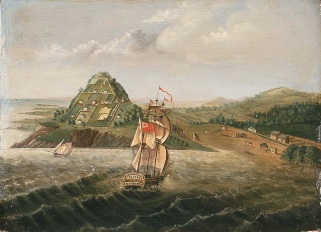Difference between revisions of "Te Puna Mission Station"
(→Historical Background) |
|||
| Line 1: | Line 1: | ||
== Historical Background == | == Historical Background == | ||
[[Image:rangihoua.jpg|right]] | [[Image:rangihoua.jpg|right]] | ||
| − | In the early years of European contact Te Puna, located in the Bay of Islands, was a focus for trading. Some of the earliest Europeans in New Zealand resided in Te Puna. In 1832 the Te Puna Mission Station was established to replace the closing [[Oihi Mission]]. | + | In the early years of European contact Te Puna, located in the Bay of Islands, was a focus for trading. Some of the earliest Europeans in New Zealand resided in Te Puna. In 1832 the Te Puna Mission Station was established to replace the closing [[Oihi Mission]] and missionaries John King and James Shepherd moved their familes from Oihi to Te Puna. |
== Location and Date == | == Location and Date == | ||
Revision as of 17:15, 21 February 2010
Contents
Historical Background
In the early years of European contact Te Puna, located in the Bay of Islands, was a focus for trading. Some of the earliest Europeans in New Zealand resided in Te Puna. In 1832 the Te Puna Mission Station was established to replace the closing Oihi Mission and missionaries John King and James Shepherd moved their familes from Oihi to Te Puna.
Location and Date
- Te Puna Mission House in the Bay of Islands
- Site PO5/24
- March 25 - April 7, 2002
Team
Archaeologists
- Ian Smith
- Angela Middlton
- Volunteers from The University of Auckland
Other Contributors
- Rod Wallace - analysis of wood samples
- Stuart Hawkins - analysis of animal bones
- Charlotte Judge -analysis of shellfish
Structural Features
Artefacts, Faunal Remains, and Wood
- 5203 pieces of bottle glass were recovered from the cellar. Over 92% of these pieces were dark olive glass. Very little were expensive or decorative.
- 1392 grams of window glass was recovered. 1357 grams was very thin glass.
- 814 ceramic fragments were recovered representing at least 97 vessels. All the ceramics were utilitarian and few were expensive or decorative. There is a predominance of London-style teawares and Willow pattern tablewares. A few sherds were matched to complete vessels of the same pattern on display at other mission houses.
- 312 clay pipe fragments were recovered from the cellar which represent at least 64 pipes.
- A large part of the fill consisted of bricks, likely from the chimney.
- Faunal remains include pig, sheep, beef, poultry, duck, and turkey. Shell midden was also found.
- The metal artefacts includ and iron bar weighing 6.868 kg, hoop metal, sheet copper, a large piece of lead, seven hinges, several agricultural tools, three cas iron pots, and five domestc irons.
- 3396 fastners were found. Of these 1197 were nails. 961 nails were wrought iron and 30 were cut iron.
- Of the largest amount of wood and charcoal found were from kauri. The next largest amount was from hardwoods.
- Several obsedian flakes were found as well as a chert flake, a grindstone, a broken sharpening stone, and a worked piece of pumice.
- Buttons, thimbles, beads and pins were also found. Only one thimble is a child's thimble.
- Nine slate fragments and 28 fragments of slate pencil were recovered.
- Three pieces of worked bone were found.
Conclusions
There is a lack of artifacts relating to children, even though seven of the King's children were living in Te Puna. Few of the glass and ceramics were decorative. Some of the ceramics showed flaws and were of seconds quality. These findings indicate that King's were living a frugal life style. The fact that the decorations on some china sherds match with whole china pieces donated to other missions by the King's daughters indicate that china was valuable to the King family. It was not easy to obtain or replace. It may have been passed down to the women of the family.
The artefacts not only demonstrate frugality but also efforts to maintain Georgian standards of propriety and appearance. The London-style tea ware shows the use of English table manners and tea drinking habbits. The recovery of domestic irons points to a larger process of washing and starching clothes and linen, all which would have been performed by women. The beads, buttons, thimbles, and pins suggest that Maori women and girls were taught to sew. They were most likely hand sewing clothing doing needlepoint. The missionaries at Te Puna were thus not just imposing Christian values onto Maori, but gender roles as well.
Records report that Maori were living at the mission and a daily basis and the finds support these records. Aside from the above mentioned needlework artefacts,the flakes and worked bones also suggest a Maori present. Also the species represented by the shell midden were all popular foods of the Maori. However the Maori artefacts could also be interpreted as curio collecting and the slate fragments and pencils by themselves do not provide proof of mission school activites. Archival evidence must be combined wth archaeological evidence in order to understand the activities at the mission house.
